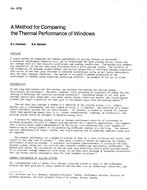Temperature, heat flow, reflectance, and emittance field data have been electronically cataloged for a full three years for 18 different single-ply membrane roofs exposed to different climates across the U.S. Our results show that the surfaces of the white thermoplastic roof systems lost about 30% to 50% of their solar reflectance after three full years of field exposure. The field data were used to validate a computer code, and simulations were run to determine the trade-off in added insulation and the increase in the cost of building roof energy caused by soiling of the thermoplastic membranes. Simulations also showed what energy costs a building owner would incur before it is economically justifiable to wash a roof.
Washing a high-reflectance thermoplastic membrane roof in Phoenix is clearly justified for roof insulation as high as R-30. In fact, building owners can realize a net savings of about 6¢ per square foot if they wash the roof every other year for a roof with a white thermoplastic membrane and R-15 insulation. In the more moderate climate of Knoxville, the advantage for washing the roof is only about 1¢ per square foot after three years of exposure for a highly reflective thermoplastic membrane with R- 15 insulation. Cooling-energy savings are offset by the heating-energy penalty, and it appears that the ratio of cooling degreedays to heating degree-days exceeding 0.4 may roughly represent the boundary for periodically washing cool roof membranes.
Citation: Thermal Performance of Exterior Envelopes of Whole Buildings IX
Product Details
- Published:
- 2004
- Number of Pages:
- 10
- File Size:
- 1 file , 3.7 MB
- Product Code(s):
- D-BldgsIX51


